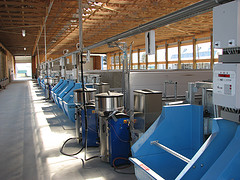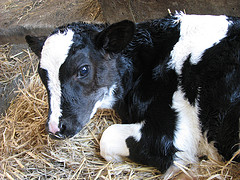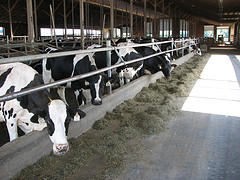Metritis is a common and costly disease that affects dairy cows during the early postpartum period. (Figure 1). Researchers at the UBC Dairy Centre have completed a number of studies investigating the relationships between health and behaviour of cows during the transition period and have found that both feeding behaviour and dry matter intake (DMI) can be used in the early detection of disease (Research Report Vol. 10 No. 1). One of these studies characterized prepartum behaviour and DMI of cows that developed metritis after calving. Relative to the healthy cows, those that developed metritis after calving spent less time at the feed bunk and had lower dry DMI as far back as 2 weeks prior to calving (approximately 3 weeks before clinical signs of disease were evident).
While this work highlights that metritis can have negative consequences on the behaviour and intake of transition dairy cattle, there has been limited research investigating the long-term impact of these changes on both milk production and culling risk.
To explore the long-term consequence of metritis, data from two previous transition cow studies were combined. Using only data from multiparous cows a population of 43 healthy animals (no fever or other clinical signs of disease by 21 days post-partum) and 16 metritic animals (had a fetid, foul smelling vaginal discharge, with a fever greater than 39.5°C by 21 d postpartum) were identified. Individual animal DMI was monitored for 21 days after calving for all experimental animals using an electronic feeding system (Insentec). During this time cows had ad libitum access to both feed and water.

Figure 2. Multiparous cows with metritis have lower average daily milk yields throughout the first 20 weeks of lactation compared to healthy multiparous cows. *Weekly averages are based on 7days of data.
Metritis during early lactation had an overall negative impact on the milk production by multiparous cows. These animals produced less milk than those that remained healthy. This reduction in milk yield was not only experienced during the metritis infection but also throughout the first 20 weeks of lactation, despite all sick cows receiving veterinary care (Figure 2).
Cows with metritis and lower milk yield also had reduced feed intake during the first 21 days after calving (Figure 3).
The reduction in feed intake during the first 3 weeks of lactation for cows with metritis may help to explain the lower daily milk yield observed in these animals over the first 20 weeks of lactation; however, it remains unknown whether these cows have decreased feed intake beyond 3 weeks after calving. The odds of being culled were 3.8 times greater for cows with metritis compared to the odds of being culled for healthy cows. Cows that were culled produced less milk than those that were not culled during the first 12 weeks of lactation.

Figure 3. Dry matter intake (DMI; kg/d) is lower during the 21-day period after calving for cows diagnosed with severe metritis relative to cows that remained healthy.
Culling decisions for the study farm were made prior to any indications of reproductive problems, as most of the cows with metritis that were culled were never bred. This finding indicates that culling decisions were likely based on disease status and low milk production of in early lactation, rather than reproductive performance.
Metritis reduces feed intake around calving, lowers 305-day milk yield, and increases culling risk in multiparous cows.
We are grateful to Julie Wittrock and Julie Huzzey for help preparing this report. For further information please email marina.vonkeyserlingk@ubc.ca or dan.weary@ubc.ca. This report is based on 2 papers published in the Journal of Dairy Science (Huzzey et al. 2007. J. Dairy Sci. 90:3220-3233 and Wittrock et al. 2011. J. Dairy Sci. 94:2408-2412; with data from Huzzey et al, 2007, and Proudfoot et al. 2009. J. Dairy Sci. 92:3116-3123). We thank the researchers and staff of the UBC Dairy Education and Research Centre for their hard work on the studies described in this report. This research was funded by the NSERC Industrial Research Chair in Animal Welfare with contributions from the Dairy Farmers of Canada and many others listed at http://awp.landfood.ubc.ca/





